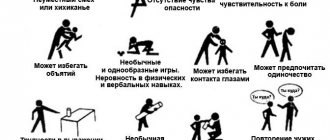School bullying - what is it? This is banal school bullying that corrupts the souls and deforms the psyche of our children.
The prevalence of this phenomenon is evidenced by the following data: about 45% of children have been bullied at school, and 20% regularly participate in it themselves. School bullying begins in primary school. The older children get, the more sophisticated the methods of school and out-of-school bullying become.
What is bullying
Bullying (from English bullying) is the systematic persecution of one of the group members (in our case, a school class) by other members of the team. Persecution is aggressive in nature and usually involves several people, which is also why the victim cannot fight back against the offenders.
Based on this definition, we can distinguish 3 main components of bullying.
- Violence (of any kind - physical, psychological, emotional).
- Group nature of violence (either the whole class or a separate group acts).
- Systematic in nature , that is, aggression does not manifest itself once, but regularly.
You need to keep these three components in mind to distinguish bullying at school from other similar, but not similar, situations.
Don't confuse school bullying with unpopularity. Yes, an unpopular child is lonely, he is not accepted into the team, they are not friends with him, and he does not chat with his classmates during breaks. He is offended, unpleasant, he feels sadness and annoyance. But not fear, as is the case with bullying. With systematic bullying, he cannot be safe, and the fear of bullying is his only companion.
It is also worth distinguishing school bullying from conflicts. Today children can quarrel or even fight, and tomorrow they are already sliding down a slide together or kicking a ball around the field. Such quarrels are inevitable, and the child learns to stand up for himself in them, throw out aggression, and defend his rights. But the main thing is that in conflicts the forces of both participants are equal (or approximately equal), and one side or another can act as the aggressor. In the case of bullying, the roles do not change: the bully always attacks, and the victim suffers.
Types of bullying
School bullying is a multifaceted phenomenon, since bullying of the victim comes in many different forms. Let's consider the main forms of such behavior.
- Physical violence. The buller influences his victim in the physical planets - this is kicking, pushing, pulling the hair. In especially severe cases - beatings. This kind of bullying is the easiest to stop because both parents and teachers notice its consequences immediately.
- Psychological abuse. A less obvious, although more common form of bullying. Aggression here is expressed in humiliating comments, ridicule, and threats. Emotional “rapists” give the victim an offensive nickname and stigmatize him: “fatty,” “bum,” etc.
- Economic violence. Everything is simple here. Schoolchildren are constantly extorted for pocket money; they may simply take away valuables: smartphones, clothes, and other items. Sometimes bullies deliberately damage clothes (tearing them, throwing them away, staining them with paint, etc.), backpacks, notebooks, etc.
- Cyberbullying. Several years ago, a special type of school bullying emerged and became widespread - cyberbullying. It involves putting pressure on the victim using means of communication. Aggressors spread defamatory information on social networks, make threats in instant messengers and by email, and film and distribute videos of bullying.
Types of bullying
Bullying can be direct or indirect; the first occurs more often among elementary school students, the second - among high and middle school students. The vast majority of aggressors are boys, and in most cases they become victims. Boys are also more likely than girls to engage in collective violent action against an outsider. The most popular methods of bullying at school:
- beatings
- taking money
- damage to personal items
- threats
- coercion to do something
- verbal aggression, insults
- defamatory gossip
- ignore (boycott)
- obscene gestures.
Cyberbullying
For cyberbullying, that is, harassment of a victim on the Internet, email and social networks are used; Photos and memes are created depicting the victim, and fragments of personal and open correspondence are published. According to the latest data, about 70% of Moscow schoolchildren participated in insulting classmates on social networks. Teachers were also subjected to humiliation - the number of teachers affected by cyberbullying in Moscow reaches 17%.
Bullying by siblings
In the struggle for parental attention, material resources, and dominance, bullying manifests itself between siblings or half-brothers. The situation can be provoked by the entrustment of parental functions to the older child, unequal distribution of material resources and affection.
How common is bullying?
According to the results of surveys conducted by specialists from Europe, every second school-age child became a victim of bullying to one degree or another. Just imagine this figure! If we extrapolate these results to the domestic educational system, we can assume that hundreds of thousands of children at this moment are suffering from attacks from aggressive classmates.
These little victims of adult neglect experience fear, shame, and other negative emotions every minute. Some feel so bad that sometimes they even think about suicide. Is this normal? Of course not.
Why is bullying at school dangerous?
Photo: https://pixabay.com/photos/woman-desperate-sad-tears-cry-1006100/
The word “bullying” is not without reason related to the verb “poison”. After all, the results of such a phenomenon can be the most serious. And at the same time, oddly enough, all participants in bullying gain negative experience: the bully, the victim and the witnesses. An aggressive child turns into a destructive personality, and witnesses live with a sense of guilt. But it is the target of bullying who suffers the most and receives the most serious injuries.
Among the most common consequences for a victim of bullying are the following problems.
- Difficulties in studying, bad grades.
- Skipping classes because you don't want to go to school.
- Psychosomatics, that is, diseases caused by prolonged stress.
- Low self-esteem, inability to believe in one’s own strength. Some children blame themselves for what happens to them.
- Anxiety and depressive mental disorders, up to the most severe forms.
- Neurotic conditions, problems with being in society. Even as an adult, the victim of bullying tries to avoid companies and groups.
- Physical injuries and even mutilation.
In particularly severe cases, emotionally unstable teenagers may try to commit suicide. According to psychological studies, victims of school bullying experience suicidal thoughts and even behavior 5 times more often than their more prosperous peers. This is a huge number.
Characteristics that make you susceptible to being bullied
There are certain character traits of a child, or the conditions of his life, that influence his becoming a victim of bullying or, conversely, the role of a persecutor. Let me give you this example: if there is an aggressive parent in the family, then this contributes to the fact that the child tries to be less noticeable in society, avoid conflicts and not attract attention to himself. If a child lacks warmth and love in the family circle, he begins to look for this warmth among his peers.
Reasons for bullying
Photo: https://pixabay.com/photos/boy-teen-schoolboy-anger-angry-2736659/
As we have already noted, bullying is a collective phenomenon, which means that one of the prerequisites for this phenomenon lies in the group. The school class is shaped from the top: students do not choose who they will be with for a long period of time. For example, a yard company is formed according to completely different principles.
As in any other team, a hierarchy begins to form in the class: from “stars” to outsiders. And at a certain moment, someone wants to establish their power by uniting friends with similar interests into their team. And this very interest may well become bullying. Offenders receive positive emotions, realize themselves better and more successful. And they want to experience this feeling again and again.
Consequently, bullying at school is a unique manifestation of collective dynamics. But then why doesn’t this practice flourish in all classes? The personality of the teacher plays a huge role here. If he condones or even approves of bullying, then a problem is inevitable. And on the contrary: when the teacher creates a favorable psychological climate in the group, then bullying is impossible.
Who can be the target of bullying? Any child who is somehow different from other children, and it doesn’t matter in what direction. Both an excellent student and a poor student can be bullied with equal force; both over the rich and over the poor; both over the fat and over the thin. Most often, children who are characterized by isolation, shyness, and lack of self-confidence suffer.
Related materials
00:02 — May 22
“They want me to die when I leave the hospital”
Due to the coronavirus, there are more victims of online bullying in Russia.
How to deal with this? In early July, State Duma Deputy Speaker Irina Yarovaya appealed to the Prosecutor General's Office, the Investigative Committee and the Supreme Court of the Russian Federation with a request to check online platforms on which children were driven to suicide. The results will help understand what measures need to be taken to help children avoid bullying.
Self-control of social networks, which still operate without uniform moderation rules for all, has not shown its full effectiveness: bullying, which most often begins within the walls of a school, still spills over into online platforms. The need to control posted content today is not enshrined in law, which creates various difficulties, for example, in deleting photographs or information about a person posted without a person’s knowledge. Many experts consider the translation of moderation into a legal framework as another important step in the fight against online bullying. A law on self-regulation in the fight against destructive content is already being developed in the State Duma.
How to understand that a child is being bullied at school
Teenagers often prefer to remain silent about their problems: they think that the intervention of parents or teachers will only increase the conflict. Another reason for silence is the fear that adults will not understand or will judge (they say, you’re already big, figure it out yourself).
And yet, there are a number of signs that may indicate bullying from classmates.
Photo: https://pixabay.com/photos/trauma-injured-violent-tear-3485235/
- Physical damage, the causes of which the teenager is unable to explain. Or his explanations seem far-fetched.
- Changes in character and behavior.
- Sleep problems. The child is tormented by nightmares and cannot sleep.
- He “lost” things: phones, headphones, gold earrings, jackets. Or these things “suddenly” break, tear, or get dirty.
- The teenager comes up with all sorts of excuses to avoid going to school. Either his stomach hurt or his temperature rose. By the way, it is possible that abdominal pain is really present, since this is how psychosomatics can manifest itself.
- Eating behavior changes. Teenagers, especially girls, stop eating. This often happens if a child is teased about being overweight.
- Academic performance deteriorates, teachers complain that the child has lost interest in studying. The corresponding entries appear in the diary.
- Sudden quarrels with friends, classmates. The teenager does not go out after school, does not call friends.
- Any behavior deviating from the previous norm: scandals, auto-aggression, running away from home, hysterics.
How to avoid becoming a victim? About victim behavior - using the example of the film “Scarecrow”
In conversations with them, the famous film “Scarecrow” was a hit. Fragments from the film turned out to be very revealing and accessible to children.
Fragment number one. A new girl comes to class. Before she can cross the threshold, her classmates trip her up and start making fun of her. What is the reason for ridicule? The fact that the girl is awkward, clumsy, with a confused smile? Or that her grandfather, a famous art collector, wears patches on his coat? No: it’s just that in this class ridicule and ridicule are the usual style of communication. Every second person has a nickname, and not the most pleasant one. Does Lena behave like a victim? Not at all. He doesn’t cry, doesn’t get offended—he smiles openly at everyone and laughs with everyone else. A very correct model of behavior... Perhaps she wouldn't have been bullied in class. After all, only the one who is offended is offended. And why the class turned against her is another story.
Rewind to another frame. Lena leaves the hairdresser. A crowd of classmates (furious with resentment that “they didn’t take me to Moscow”) surrounds the girl and begins to fire at her with tubes. What is the girl doing? Why doesn't he go back to the hairdresser? Won't he call an adult for help? He won’t turn around abruptly and say, “Get away from me!” won't go home? No, she looks in confusion at the crowd of brutal classmates, clumsily dodges shots, grabs her bruised places. Is she acting like a victim? Yes!
Further more. Classmates climb into Lena's garden and take her dress off the rope. And then they start playing “dogs” with this very dress. They showed it, teased it, and started throwing it at each other. Lena runs in circles, trying in vain to catch her dress. Why is she doing this? And what behavior would be the most logical in this situation? Give up and go home. And at home, tell the adults that some unsound children climbed into the garden and actually committed a theft. And let the adults go to the parents of the hooligans and demand they buy a new dress. Or to the police. Or to the school principal. And this will become a problem for hooligans. And the girl, who, like a dog, ran in a circle and frantically tried to snatch the dress from the hands of the brutal crowd, behaved like a typical victim.
Perhaps the example of the heroine of “Scarecrow” was a little distorted (after all, the girl’s love experiences were also involved), but still. I confidently convey the following to teenagers: you must know that NO ONE, under any circumstances, has the right to treat you THIS way. When ridicule and mockery are taken not for granted (I deserve it, I’m guilty, I’m bad), but as something completely alien, this is what allows you to avoid becoming a victim.
And the algorithm of actions will already be dictated by circumstances, multiplied by temperament: either being lazy, or complaining to mom, or kicking open the door to the school principal’s office and loudly demanding an end to the lawlessness on the part of classmates. Any option will be correct - but just don’t silently swallow tears with the thoughts “that’s what I need.”
A child is bullied at school: what to do?
There is no one right answer to the question of how to deal with bullying. But the most important thing is obvious - it is necessary to declare the problem, voice it, call bullying bullying. Then the aggressors and witnesses will understand that this is not a fun get-together, but a shameful act. This must be done by the teacher or director.
Psychologists are convinced that it is useless to solve the situation in terms of “victim – buller”, since in one way or another the whole class is involved in this process. Therefore, the main task of the teacher and school psychologist is to create a normal atmosphere in the team. But all this is possible if teachers and management meet the requests of parents.
If bullying - psychological or physical - does not stop, you need to act differently.
Combating psychological (other) bullying
Proceed as follows.
- Contact the school administration. Be sure to include a written statement with your application. List all the facts indicating bullying and the consequences of such bullying. According to the law, the director must respond to the application within a month.
- Make your suggestions. Perhaps you have an opinion on how to solve the problem. Propose it, discuss it with psychologists and teachers. Involve people from the outside - perhaps it will be a specialist from a private institution.
- Contact higher authorities. If the school administration does not respond, write a statement to Gorono or Rayono, Rosobrnadzor, or the Ombudsman for Children’s Rights in your region. Officials must respond to such requests within a month.
- Think about the public. If this doesn’t help, then ring all the bells. Write posts on social networks, seek help from popular information sites, newspapers and channels. As an option, contact organizations that deal with a similar problem.
Combating physical bullying
It is very dangerous. You need to do the following.
- Do not allow your child to go to school if he or she comes home with serious injuries.
- Be sure to apply for a medical examination. The doctor will remove the beatings and give a certificate. This is proof! They can also include threatening messages and videos of beatings.
- Contact the police and prosecutor's office.
- Write an application addressed to the official responsible for education in your city or region.
- Reach out to the public. These could be non-profit organizations, the press, deputies, or the ombudsman.
How to help a child
But the most important thing is to help the target of bullying. How to do it?
Photo: https://pixabay.com/photos/family-mom-daughter-baby-teen-3817046/
- Show that you are on the teenager's side. You can’t tell him that this will pass, that it’s his own fault, don’t pay attention, etc. The child is looking for protection and support from you. You are required to provide them.
- Contact a psychologist. Because of bullying, a child’s self-esteem inevitably suffers, and his understanding of how to communicate with peers in society is disrupted. We need qualified help from a psychologist.
- Raise your child's self-esteem. Of course, this is not an easy process, complex and lengthy. But without this it will be impossible to return the teenager to normal life. What can be done? Offer hobbies and sports clubs. That is, an activity where he can see his own importance.
Don't expect the situation to improve without your intervention. Of course, at some point, the aggressors may get tired of bullying your child and they will switch to another victim (which is also terrible). But by this time the problem will have gone too far, and the child’s self-esteem will drop below the lower limit.
Psychological portraits of participants in bullying
A bullying situation involves the victim, the persecutor, and bystanders. Psychologists have come to the conclusion that each of the roles is to some extent a reflection of a person’s personal qualities. Therefore, children with certain character traits are at risk.
Typical victim of school bullies
Most often, children who are victims of school bullying have the following characteristics:
- sentimentality
- sensitivity
- increased anxiety
- low self-esteem
- tendency towards solitary leisure.
Children with a similar character play little with their peers, preferring the company of adults, books, and computer games. They cry often, are prone to bouts of sadness, do not like sports and are in poor physical shape. The typical victim of persecution is withdrawn, does not get along with others, and has a low opinion of his attractiveness and intelligence.
The listed qualities appear as consequences of bullying, but can also provoke it. For aggressive peers, these personality traits are a signal that they are easy prey.
Children with poor health are persecuted more often, especially if chronic illnesses have affected the child's appearance. Among the diseases that victims of bullying suffer from, the following are in first place:
- obesity
- diabetes
- ADHD
- autistic disorders
- epilepsy
- hormonal pathologies.
Girls and boys whose appearance and mannerisms are perceived by their peers as inappropriate for their gender are often persecuted. “Feminine” boys or girls who prefer gender-neutral clothing and accessories face threats and aggression more often than others.
Characteristics of a child stalker
The typical bully is impulsive, has an explosive temperament, and bullies others to assert himself. A child can be deliberately rude, demonstrate a lack of emotion and ostentatious aggression, and create an image of a renegade and marginalized.
In reality, this behavior is just a mask. Persecutors are usually well socialized, enjoy authority, are surrounded by friends, and, unlike victims, rarely experience loneliness. Children who are bullies are much less likely to suffer from depression and anxiety disorders than children who are outsiders.
Stalkers have high emotional intelligence, which they use to manipulate others by exploiting their feelings and states. They bully the weak in order to gain material and psychological benefits: authority, power, money, valuables. By offending another, the aggressor receives moral satisfaction - confirmation of his strength.
Provoking victim
Some children combine the behavior of an aggressor and a victim; act in both roles in relation to different people. For example, having received an insult from the main bully of the school, they rush to take it out on a harmless child from their class. A “provoking victim,” as psychologists call such children, often behaves aggressively. She has poor self-control and level of social adaptation, and low popularity in class. The child has difficulty assimilating information and often experiences anxiety and depression. He rarely enjoys the love of teachers and is prone to suicide and self-harm.
Witnesses of bullying
The behavior of witnesses determines the development of the conflict. Having received support, the bully intensifies the attacks, but seeing condemnation and compassion for the victim, he stops them.
Most children deep down sympathize with the victim, but out of fear of taking her place they do not support the persecuted. Conflicting feelings are raging in the souls of the witnesses - guilt for passivity and the desire to attack the victim along with the instigator. If children constantly observe the humiliation of the weak, they gradually lose the ability to sympathize.
The role of the teacher in what is happening
Looking at the tragedy unfolding before their eyes, the children duplicate the teacher’s attitude to what is happening. Teachers often let bullying take its course, believing that it will teach the child healthy interaction with team members. The teacher shifts responsibility from the aggressor to the victim, guided by stereotypes:
- you need to be able to stand up for yourself
- you can't avoid the company of others
- bullying teaches you how to adapt to society.
The teacher may not voice such beliefs. Children adopt this policy unconsciously, guided by the example of the teacher, especially if he has authority. Although the class teacher understands the mechanisms and possible consequences of what is happening, in some cases he prefers to maintain a neutral position and not interfere. Because of this, bullying continues and can take threatening forms. An adult, if desired, can stop violence; How safe a child feels in the school community depends on his behavior.
Should I transfer my child to another school?
It is generally accepted that it is not worth transferring a teenager who has suffered from bullying to another educational institution. Like, if he plays the role of a victim here, then the same thing awaits him in the new place. This is a wrong point of view. We said above that absolutely any child can become the target of bullying, and the situation is worsened by the non-intervention of the teacher.
If a child has the opportunity to choose a team, teacher or school, then such a transition has the potential to change the course of history. Moreover, it is necessary to change the educational institution if teachers turn a blind eye to the problem, or even blame the teenager himself for the current situation.











